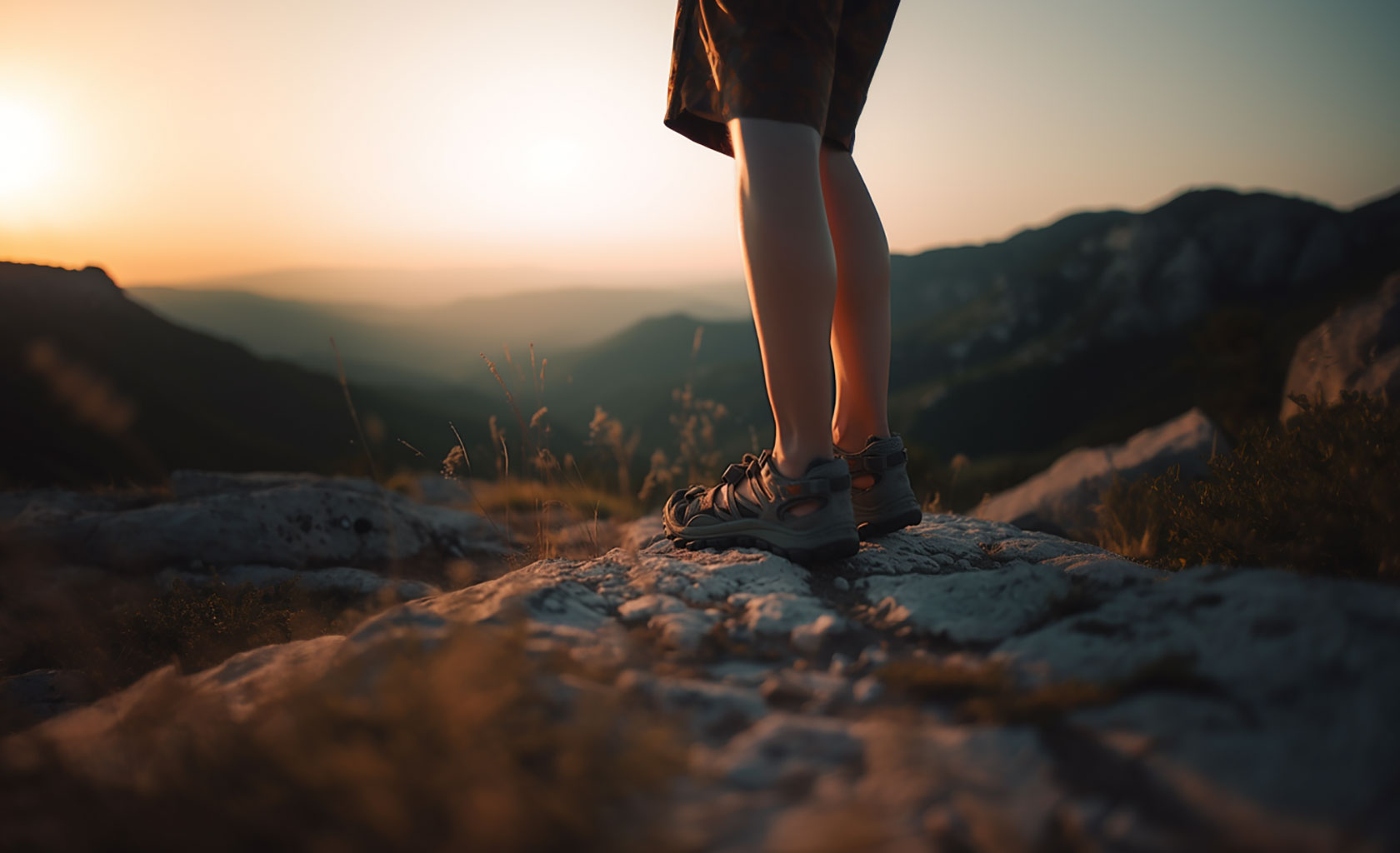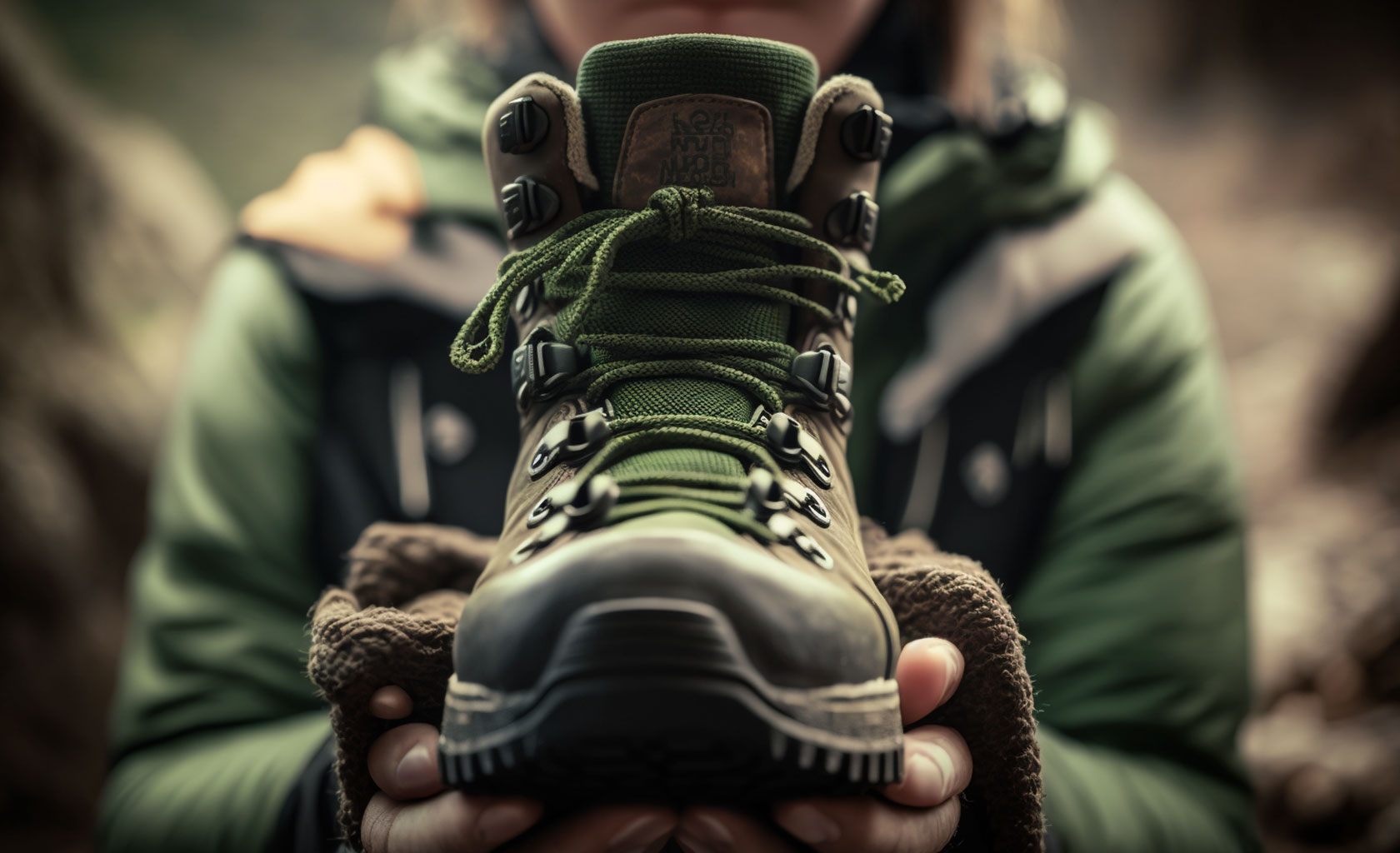A funny task presented itself before designers and manufacturers of hiking boots. How to create the best hiking boots when everything a boot traditionally is and requires, is not what hikers need or want. How so? Well, traditionally, boots are worn when it is cold outside. Yet, the best hiking boots should be able to comfortably handle all weather conditions. Next, boots should be warm. But again, if you want to make the best hiking boots you have to make them breathable. They should also be sturdy but light and provide ankle stability but also comfort. The list of these discrepancies goes on and does not get any easier.
For all these reasons, our list of best hiking boots for 2023 is long. The manufacturers had so many variables to consider, and they had done so in so many remarkable ways. So, ladies and gentlemen, we give you our mighty eight, best hiking boots selection for 2023.
QUICK PEEK
Here it is, a glance of what we have chosen. Check the text below if you are in for some reasons and details.
- Best hiking boots overall: Salomon X Ultra 4 Mid GTX
- Might have as well been the best hiking boot overall: Salomon Quest 4 GTX
- Best all-weather hiking boots: Altra Lone Peak All Weather Mid 2
- Best hiking boots for the budget: Merrell Moab 3 Mid WP
- Best off-trail hiking boots: La Sportiva Ultra Raptor II Mid GTX
- Best hiking boots for wide feet: Keen Targhee III WP Mid
- Maximum cushioning and comfort: Hoka Anacapa Mid GTX
- Best hiking boots for backpacking: Lowa Renegade Mid GTX
1. SALOMON X ULTRA 4 MID - THE BEST HIKING BOOTS OVERALL
Pros: Extremely lightweight, supportive and fast
Cons: Less stability than the big brother below
Salomon Ultra 4 Mid are a Swiss army knife. An ultimate combination of all features the best hiking boots should provide.
What does this mean exactly? Well, to start with, Salomon X Ultra 4 Mid have an excellent ankle support and a wide and highly protective chassis – the two traditional must-have qualities of hiking boots. Next, the traction is flabbergasting and guarantees a safe step all terrains. These hiking boots are also very stable and have the typical Salomon quality known for the ability to handle both use and abuse. But the very reason we put Salomon Ultra 4 Mid on top of our Best Hiking Boots for 2023 list is that all these qualities, including Gore Tex lining and leather straps on lacing, come with a weight of just 1 lb 14 oz. Compared to majority of other hiking boots, it is like they are an aluminum feather among chunks of raw iron . A true wonder we dare say.
Getting such low weight without compromising quality, stability, protection and support seems almost impossible. But Solomon has done it there we have it. A true uncompromising transition from a trail runner to a hiking boot. The only potential downside of these boots is the midsole, which we would love to have slightly softer. But irrespective of this, Salomon X Ultra 4 Mid remain a surprise of the decade. If you wisht have only one pair of hiking boots to handle
cold and hot weather, hiking and backpacking, fast trail hikes and rocky off trail terrains, stop your search and buy these little beasts. They offer so much for more than a fair price.
2. SALOMON QUEST 4 GTX - MIGHT HAVE AS WELL BEEN THE BEST HIKING BOOTS OVERALL
Pros: Top stability and cushioning, excellent for backpacking
Cons: Slightly heavy
Every now and then, a man or a woman needs heavy artillery, hoping it will do the job and not get stuck in the mud. Translated to hiking, when you need steady, reliable, hard-working boots that will never ever fail you, always get you moving and out of the trouble, you get yourself a pair of Salomon Quest 4 GTX. Think of them as a tank advancing a hill. Unstoppable.
Salomon Quest 4 GTX have taken a second place on our Best Hiking Shoes for 2023 list for how they combine what a hiker needs from a boot. These hiking boots are as stable as it gets. They offer remarkable traction, top-notch ankle support, reliable lacing, excellent toe protection and considerable cushioning overall. Considering the reputation of Salomon as a manufacturer and the fact that these boots are already a third generation of its kind, we believe there is no need to further explain their toughness and durability. So, if you love rough terrains, heavy backpacking, and place safety of your feet high on your priority list, you have found yourself the best hiking boots ever.
The only reason we decided not to put Salomon Quest 4 GTX on the first place of our list is their weight. Namely, with 2 lb 14 oz they still belong to the mid-weight category and do require some breaking-in, unlike their brother above. But again, if you hike heavy packed, or like to go off trail and take your feet to the limits, these boots will be your most reliable companion.

3. ALTRA LONE PEAK ALL WEATHER MID 2 - BEST ALL - WEATHER HIKING BOOTS
Pros: Ultra light, extremely comfortable
Cons: Less durable compared to others on the list
Being able to comfortably wear a hiking boot irrespective of the weather outside might not seem a reason sufficient enough to put a boot on the third place of the Best Hiking Boots for 2023 list. However, Altra Lone Peak All Weather Mid 2 go beyond coping with the weather. They annihilate it.
These hiking boots are extremely lightweight and comfortable. All hikers agree that absolutely no break-in period is required. Such agreement does not often happen in the hiking world. But that is not what they excel at. The whole point of these boots is that their 1 lb 14 oz, eVent membrane, famous Altra cushioning and zero drop feature will make you completely unaware of the elements. Yes, that is how good these boots feel wearing. At all times. They are the chameleon on our list of Best Hiking Boots for 2023 – wear them in the desert or across a frozen creek and they will behave like that is exactly what they were born to do.
These boots are a transition from trail runners to hiking boots. Almost as a rule, this implies more comfort but less durability. Altra Lone Peak All Weather Mid 2 are no exception. They will cuddle your feet and provide sufficient support but not for as long as some other competitors on the list. Yet, if you prefer long on-trail hikes and absolutely despise any discomfort, you will not mind having to buy another pair of hiking boots sooner than you expected.
4. MERRELL MOAB 3 MID WP - BEST HIKING BOOTS FOR THE BUDGET
Pros: excellent value for the money
Cons: slightly lack in appeal and support
It seems that none of the lists of best hiking footwear in any category can be formed without the honorable Merrell Moab. Even though these shoes are almost regularly labeled as the cheapest, the low price itself is not the reason for such high rankings. It is what you get for the low price you pay.
Merrell Moab 2 Mid WP hiking boots are solid, strong and cheap. For more than a reasonable price, you get very reliable and long-lasting hiking boots with Vibram outsoles and a Merrrell’s own waterproof membrane. These two mean stability, quality and quite good waterproofness. Despite their not so low weight of 2 lb 0.7 oz, these boots are very flexible require almost no break-in. Also, the most recent upgrades of the model offer improved overall comfort, fit and traction which makes them favorite amog backpackers. All in all, a well-deserved number 4 on our Best Hiking Boots for 2023 list.
What are the drawbacks of these boots? Well, Moab is obviously not particularly interested to trade their well-known value for the money for improved looks. This is to say that the design of the boots remains simple and sturdy. However, despite the fact that they decided not to participate in this let’s-look-our-best race, Merrell manages to keep its place in the hikers’ hearts and pockets. So, if you don’t like to overpay a perfectly good boot and don’t mind potentially outdated design, Merrell Moab 3 Mid WP is the best choice.
5. LA SPORTIVA ULTRA RAPTOR II MID GTX - BEST OF TRAIL HIKING BOOTS
Pros: stability and durability in a trail runner design
Cons: would prefer slightly deeper lugs, narrow fit
La Sportiva Ultra Raptor II Mid GTX are as far as it gets from their pall above. Yet, their place on the list of Best Hiking Boots for 2023 is everything but undeserved. As we said at the beginning, hiker’s needs can be met in so many remarkable ways. Hence the versatility.
To start with, La Sportiva Ultra Raptor II Mid GTX hiking boots look good. Very good actually. Yet, their sporty, flexible and muscular design is not an empty promise. They have stiff FriXion XF 2.0 sole, highly protective toe cap and TPU heal, all adding to the overall stability and excellent traction of these high-tech hiking boots. They also feel great around the ankles, and provide efficient lacing. All this makes them excellent for longer off-trail hikes.
It is important to mention these technical qualities because, similar to Altra Lone Peal All Weather, La Sportiva Ultra Raptor II Mid GTX are also a trail runners grown to the level of hiking boots. This generally means improved comfort, but at the cost of stability and durability, which does not entirely apply here. To sum up, these 2 lb 1.2 oz boots are a high-performing combination of comfort, stability, traction and protection. They show their best on mountainous and technical terrain. So, with La Sportiva Ultra Raptor II Mid GTX you will move up quickly, all cushioned and well protected. However, in order for these to be the best hiking boots for you, please keep in mind that La Sportiva generally has a narrow fit. Make sure to check the sizing before buying.
6. KEEN TARGHEE III WP MID - BEST HIKING BOOTS FOR WIDE FEET
Pros: great durability and toe protection, excellent value for the money
Cons: lower ankle support
Here is a fact for you. Despite ever changing trends and novelties in the industry, a straightforward list of best hiking shoes for 2023 simply cannot do without good old Keen Targhee III. Released in 2017, these hiking boots are a true veteran among the crew. A golden standard, some would say.
So, what are these old hiking boots doing in an updated list of best hiking boots for 2023? They are keeping their well-deserved place. And here is why. Keen Targhee III WP Mid are remarkably durable, strong and tough. They offer rubber outsole, leather upper, KEEN.DRY waterproof membrane, a generous toe cap, and excellent traction. Also, they are well-known for their wide toe box which accommodates natural foot shape. This quality makes them ideal for all those who prefer more freedom for their toes. Moreover, for 2 lb 2.8 oz, you also get quite enough flexibility and comfort. So, if you prefer your toes to wiggle, all dry and safe, search no more.
Is there anything we do not like about Keen Targhee III WP Mid? One thing only – their ankle support comes low. This does not make them perfect choice for all those who love how protected they feel in a more boot like model such as Lowa Renegade below. Yet, keep in mind that precisely these boots, along with Merrel Moab, have been keeping the highest sales records for years. People love them and so will you.
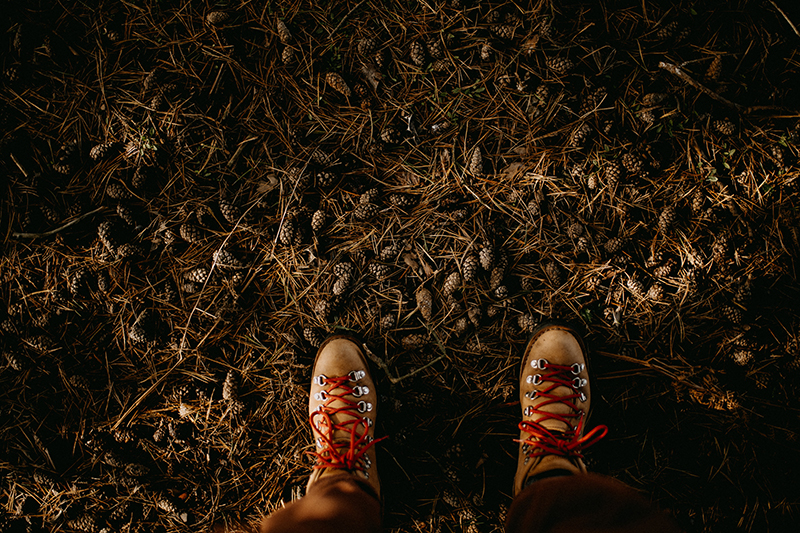
7. HOKA ANACAPA MID GTX - MAXIMUM CUSHIONING AND COMFORT
Pros: supreme comfort and cushioning, great for long hikes
Cons: lower outsole durability, pricy
Hoka Anacapa Mid GTX hiking boots are a fluffy mist. Wearing them feels like walking in the clouds. Literarily. One cloud on one, and one on the other foot.
Hokas are famous for their cushioning and comfort and these hiking boots are nothing but another flag ship representative of their manufacturer. With their flashy design, they boots give highly flexible and bouncy midsoles, protective leather uppers, Gore Tex waterproof membranes and highly efficient over ankle lacing. They are light (2 lb 0 oz), fast, and give you a sensation of completely smooth and harmless movement. They make technical terrains seam silky. And you cannot help looking at them.
Yet, as another example of a trail runner turned hiking boot, Hoka Anacapa Mid GTX lacks durability, primarily that of the outsole. This is because the blown rubber (air injected into the compound) in the middle part, provides comfort but does not sustain damage as efficiently as Vibram. Also, the comfort they provide might even prove excessive. As experienced hikers know, it is dangerous not to be able to properly feel the texture of the terrain under your foot. However, if you mainly stick to established routes, appreciate fast movement and ultimate comfort, you will have no trouble spending some extra bucks to get yourself a pair of these hiking moon boots.
8. LOWA RENEGADE MID GTX - BEST HIKING BOOTS FOR BACKPACKING
Pros: great mix of support and comfort
Cons: could be more durable for the price
A typical representative of hiking boots as a class. The mule among hiking footwear. Built to carry heavy loads, people and backpacks included.
Lowa Renegade Mid GTX give so much. They have a high cut, tough but comfortable ankle support, solid leather all over, grippy Vibram outsoles and lugs that perfectly handle rocks, roots and dirt, especially when declining a slope. With their leather upper and Gore Tex lining, these boots will not leak a drop. Strangely enough, they will also not feel too warm on summer hikes. On top of all this, Lowa Renegade Mid are astonishingly comfortable. Their weigh is not excessive (2 lb 7 oz), their cushioning is remarkable, and underfoot very comfortable. Such reduced weight, overall comfort and stability make them the best hiking boots for heavy backpackers on demanding trails.
Are there any downsides? Yes. First it is the price. Lowa Renegade Mid GTX are the most expensive boots on our list. Yet, they are not as durable as Salomon Quest. However, the perfect balance of weight and support makes people come back for more.
COMPARISON TABLE
Money matters. For this reason, the boots have fist been listed according their price, from the cheapest to the most expensive. Next column shows weight (1 for the lowest and 8 for the highest). Remaining columns show relation between the price, weight and our thoughts of the boots (position on our list of best hiking boots in 2023), followed by brief and concise reasoning. All this is because we want you to shop easy and wise. Hence the table below.
| Name | Price | Weight | Our rating | Reason |
| Merrell Moab 3 Mid WP | 145 $ | 2 lb 0.7 oz | 4 | Not as agile and comfortable as the top 3. |
| Salomon X Ultra 4 Mid GTX | 175 $ | 1 lb 14 oz | 1 | Top ratio of comfort, protection, durability and flexibility. |
| Keen Targhee III WP Mid | 175 $ | 2 lb 2.8 oz | 6 | Lower security on tough trails, warm (overall leather structure). |
| Hoka Anacapa Mid GTX | 185 $ | 2 lb | 7 | Lower outsole durability on technical terrain. |
| Altra Lone Peak All Weather Mid 2 | 190 $ | 1 lb 14 oz | 3 | The best among trail runners turned hiking boots. |
| La Sportiva Ultra Raptor II Mid GTX | 209 $ | 2 lb 1.2 oz | 5 | Great for mountains, not great for mud (shallow lugs). |
| Salomon Quest 4 GTX | 230 $ | 2 lb 14 oz | 2 | No boot has ever been so protective and comfortable at the same time. |
| Lowa Renegade Mid | 255 $ | 2 lb 7 oz | 8 | High in cost and weight. But great anyway. |
BUYER’S GUIDE - THINGS TO CONSIDER WHEN BUYING HIKING BOOTS
The best hiking boots should match your feet, your needs and your persona. Not an easy job. Consider following important qualities when buying.
Weight
As you can see from the table above, weigh of the hiking boots varies significantly. For example, you have Salomon X Ultra 4 Mid GTX that weigh 2 times less than Lowa Renegade and yet both belong to the same category of hiking footwear. So, what causes this discrepancy and why is it important?
Similar to hiking shoes, the weight of hiking boots depends on two matters:
- Materials used
- Height of the boot
Generally speaking, more weight equals more protection and a higher cut. Also, weight contributes to the overall performance of the boot, meaning that heavier boots most often offer better stability and durability in the long run. Yet, weight is what modern hiking boots manufacturers are doing their best to cut down. This is because comfort and sensation of light feet are taking the precedence over sturdiness and durability. Different categories of hiking boots have appeared as a consequence, similar to those in boxing.
Lightweight hiking boots
Boots belonging to this category put an accent on comfort, cushioning and an overall ease of wearing them. Salomon X Ultra 4 GTX Mid and Altra Lone Peak All Weather Mid 2 are typical representatives of the type, light, comfortable and cushy. How is this weight decrease achieved and at what cost? The answer is materials.
Leather in the upper part gets replaced by nylon, polyester and mesh. These materials are lightweight and breathable, allowing air to circulate around the foot and preventing it from becoming too hot or sweaty. They also require less maintenance than leather. Also, the midsoles of this category are most often made of lightweight EVA foam (ethylene-vinyl acetate) famous for its excellent cushioning properties. All these upgrades increase comfort and cut down on production costs but also decrease durability and reliability. Again, as long as you are not carrying heavy backpacks, these boots will do the job you engaged them for.
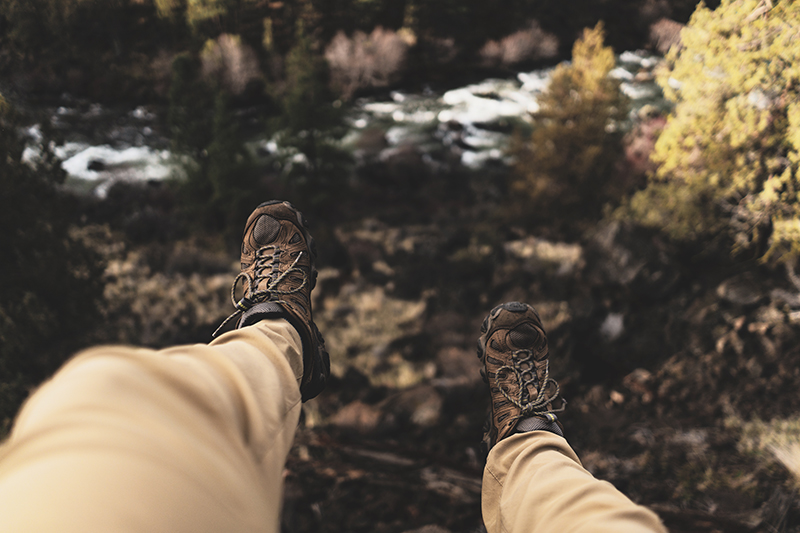
Midweight hiking boots
These boots offer a high level of compromise between durability and protection on one and comfort and lightness of step on the other side. They stand as a perfect balance between modern inclination to turn trail runners into hiking boots and a historically proven fact that more weight means more safety. They provide more support in the midsole, become slightly stiffer and consequently more expensive. It is fair to say that the need for this category of hiking boots is also increasing due to an increased popularity of shorter backpacking hikes. Strangely enough, the heaviest boots on our list, Lowa Renegade Mid, actually belong to the widweight category. This means one thing only – high quality hiking boots can weigh more than 2 lb 7 oz.
Heavyweight hiking boots
Boots belonging to this category do not compromise. With them, safety and protection always come first. The blisters and tired feet are just a side effect of hiking as a sport.
When it comes to material, both heavy and midweight hiking boots use leather. Also, highly reliable Gore Tex membrane is almost a rule of a thumb. Midsoles of both categories are typically made of EVA foam, PU foam (polyurethane), or combination of these. Between the two, PU foam is denser and more durable than EVA, providing better support and stability on rocky or uneven terrain. Some mid and heavyweight hiking boots may also use TPU (thermoplastic polyurethane) inserts in the midsole to provide additional support and stability.
The outsoles are usually made from a durable rubber material with deep lugs or treads that provide excellent traction on a variety of surfaces. Some also use Vibram soles, which are made from a special type of rubber that provides superior grip and durability.
Waterproofness
In 99% of cases, this is a must-have quality of best hiking boots. The 1% goes to people who hike exclusively in hot and dry conditions. For 99% of us it is still fuss with water and mud.
Waterproofnes stands for ability of the best hiking boots to keep your feet dry and comfortable. The key role is again played by the materials and the technology.
The common method hiking boots manufacturers apply is the use of waterproof membrane, such as Gore-Tex, which is designed to keep water out while still allowing air to flow through. These membranes are often combined with water-resistant coatings on the outside of the boot to create a barrier that repels water and prevents it from seeping in. Please note that, apart from famous Gore-Tex, some manufacturers have developed their own waterproof membranes, such as KEEN.dry, which perform quite well.
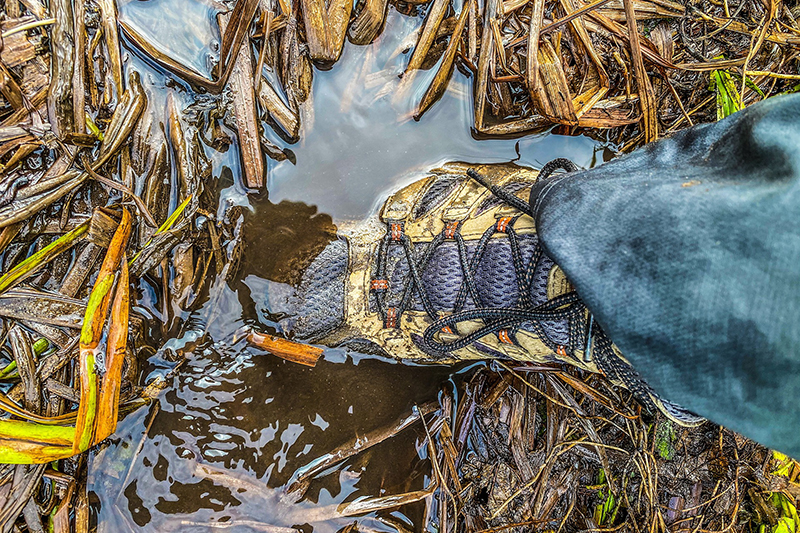
Breathability
As important as waterproofness. Unfortunately, many remember this feature only in its absence, when sweaty feet are looking for relief but it is nowhere to be found.
Breathable hiking boots are those that allow air circulation through the boots themselves. The ventilation enables sweat to evaporate out. This prevents blisters, fungus infections and general discomfort. But can a hiking boot be both waterproof and breathable? Does not one exclude the other?
To a specific extent, yes, despite what manufacturers may claim. It is only logical. Waterproof membranes hold off the water from the outside. The temperature inside the boots increases, causing the feet to sweat more. As a consequence, waterproof hiking boots will make your feet wet.
How to secure breathability
Here is a simple truth for you. You have to embrace the fact that your feet inevitably will get wet at some point when hiking in bad weather. Waterproof membranes do a great job preventing the water to come in but their breathability level is not as high as we would love it to be. Again, if you decide for heavyweight leather boots with polyurethane coating, no water what so ever will penetrate from the outside but your feet will soak in their own sweat.
The only thing you can do about it is to choose your hiking boots or hiking shoes carefully. Consider the weather you expect, trail type and duration of your hike. Experienced hikers even tend to chose non waterproof hiking boots for hikes on rocky terrain under mild temperatures, despite the rain or mud. This is to say they prefer breathability over waterproofness as long outside temperature is not too low.
Traction
Traction stands for ability of a hiking boot to balance your weight against the terrain to enable a safe step. Basically, it refers to shoes ability to grip the ground and prevent slipping. This is precisely where hiking footwear dominates over other sports shoes.
Traction comes down to two things: lugs and outsoles.
Lugs
Lugs are the bumps on the outsole. They dig into the ground, create friction and enable traction. Their depth and shape vary greatly and depend on the terrain. However, it is safe to say that shallow and mixed thread lugs are good for grass, gravel and not to steep easy to moderate trails. At the same time, moderate hiking and backpacking require deeper lugs, while technical terrains, rocks, snow, mud, steep sides require more protection – deep lugs, heel breaks (prominent lug pattern on the heal) and angular pattern (V shaped lugs and Z shaped ridges, as opposite to rounded lugs).
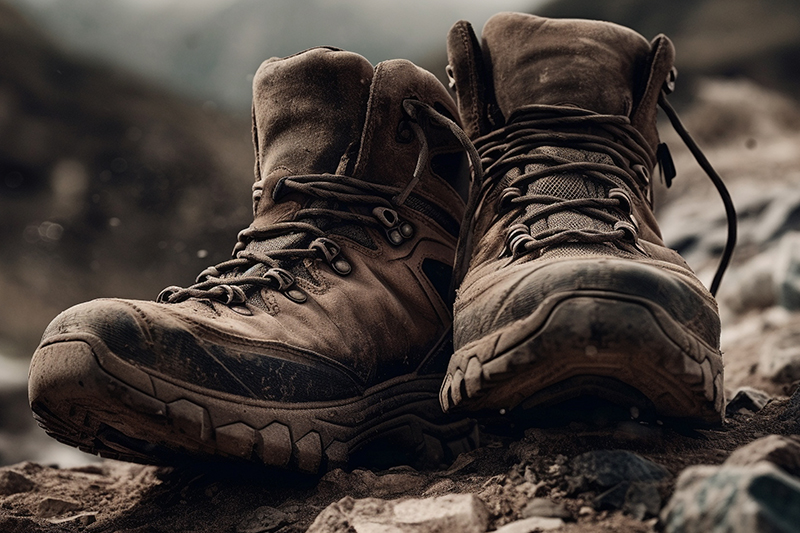
Outsoles
We tackled these slightly in the section describing weigh categories of hiking boots. However, the role the outsoles play in traction as to be underlined. So, when looking for the best hiking boots, look for rubber. It is heavier than PU, but performs better and lasts longer. You also have TPR (thermoplastic rubber) oustoles, as a hybrid of the two. These provide less weight and improved grip. Nonetheless, rubber is the golden standard here, Vibram included. Note that Vibram is just a brand name, not a specific material. Yet, they are doing such a great job that Vibram has become a second name for safe steps.
However, some hiking shoes manufacturers use their own technology to produce outsoles. Salomon is an example. Their in-house Contagrip compound has proved remarkable in a variety of situations, from fast and light hiking to heavy backpacking.
Hiking boots uppers
The upper hiking boot materials have a decisive impact performance of the boots. They directly define breathability, waterproofness and durability. Generally speaking, hiking boots uppers are made of:
- Nubric leather – maximum waterproofness, high durability, low breathability
- Nylon and mesh – lower waterproofness, high durability, great breathability, lower weight
As you can see, various materials offer various benefits. Luckily enough, manufacturers recognize hikers’ needs and produce boots that combine these materials. As a hiker, you have to assess your own needs based on the info we provide and find yourself the best hiking shoes there are. And they are out there, we promise.
Lacing
In hiking, the way you lace your shoes is not a matter of fashion. It is a matter of function, comfort and time.
Lacing is important. So much that manufacturers continuously think of finding new ways to lace the hiking boots up. This is because lacing affects overall comfort of hiking footwear. It should also be fast and reliable since having a loose lace when trying to hold balance on slippery terrain is not a funny thing to experience. Also, you do not want to waste time and risk blisters readjusting your laces every once in a while.
Modern hiking boots mainly offer two types of lacing: traditional and single-pull speed lacing. Traditional lacing is more reliable and offers more adjustment compared to single-pull lacing which is much faster but is not as customizable as traditional lacing, as the tension is applied evenly across the entire length of the boot. Additionally, the locking mechanism can sometimes slip or become loose, which may require readjustment during use. For all these reasons, including easier replacement, our votes go to traditional laces.
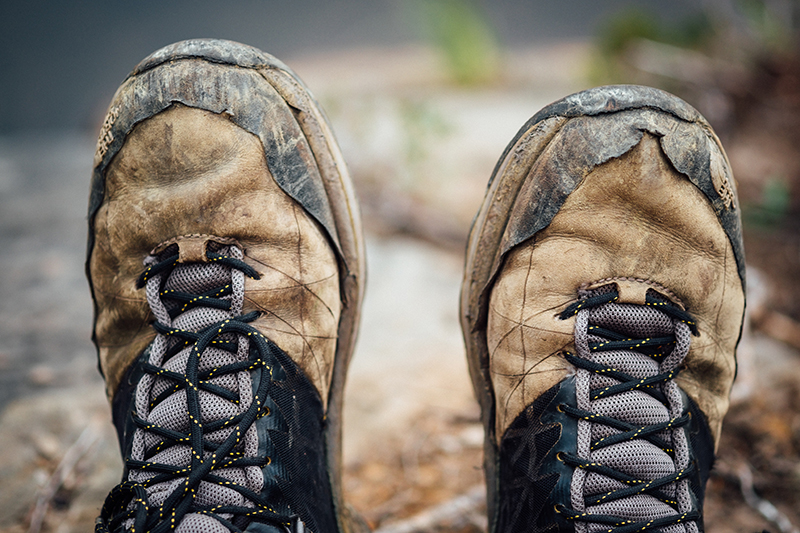
Toe cap
This is a piece of rubber placed at the very front of your hiking boots with aim to protect your toes. At first, it might not seem that important. Yet, if you happen to hit a rock while carrying a heavy backpack you will wish you had not a rubber cap but a whole rubber bumper.
To sum up, if you hike on mild terrains and do not carry too much load, you are free to choose boots without a toe cap. However, if this is not the case, we highly recommend you chose hiking boots with toe protection. It does not add much weight and can prove most useful.







